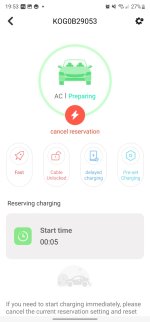Jones886
Established Member
Hi all hope is well so I've decided to take the plunge today and try out eon's new ev drive tarrif I'm doing a test run for a month and will post my findings how I go so here is a low down on the costs and what it involves and what I'm doing to try cut costs.
Previous eon tarrif
32.81kwph (24 hour pricing)
New tarriff
47.34kwph 07.00 am till 00.00am (day rate)
10.99kwph 00.00am till 7.00am (night rate)
The steps I plan to take to make full use of the 10.99 kwph rate
. Washing machine on from 2 am (pre set on a time delay)
. Dishwasher on from 00.00 before I go to bed. This is around when I do go up so not causing me massive issues but will see.
. Ordering digital time delay plugs from amazon to charge up the kids ipad,s and phones overnight including ours.
. Using a project ev charger which I have time delay set to come on from 00.05 hours now plugged in ready to charge.
Things I'm worried about
. Having items charging when in bed around the house washing machine on etc.
. Will It become more costly based on the day rate charge ?
Best case - partner works 3 nights a week so doesn't have anythink running in the day.
. Kids at school
. I'm working 08.00 till 5pm
Worst case
. School holidays increased day usage
. Does it start to grind on me remembering to do the daily tasks of having multiple items on ready before I go to bed in other words been arsed to get up off the sofa.
Hope you all enjoy the thread and look forward to the comments
Previous eon tarrif
32.81kwph (24 hour pricing)
New tarriff
47.34kwph 07.00 am till 00.00am (day rate)
10.99kwph 00.00am till 7.00am (night rate)
The steps I plan to take to make full use of the 10.99 kwph rate
. Washing machine on from 2 am (pre set on a time delay)
. Dishwasher on from 00.00 before I go to bed. This is around when I do go up so not causing me massive issues but will see.
. Ordering digital time delay plugs from amazon to charge up the kids ipad,s and phones overnight including ours.
. Using a project ev charger which I have time delay set to come on from 00.05 hours now plugged in ready to charge.
Things I'm worried about
. Having items charging when in bed around the house washing machine on etc.
. Will It become more costly based on the day rate charge ?
Best case - partner works 3 nights a week so doesn't have anythink running in the day.
. Kids at school
. I'm working 08.00 till 5pm
Worst case
. School holidays increased day usage
. Does it start to grind on me remembering to do the daily tasks of having multiple items on ready before I go to bed in other words been arsed to get up off the sofa.
Hope you all enjoy the thread and look forward to the comments
